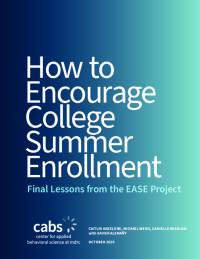How to Encourage College Summer Enrollment
Final Lessons from the EASE Project

Despite the benefits of taking summer courses, most community college students do not do so. MDRC’s Encouraging Additional Summer Enrollment (EASE) study used behavioral insights and a financial incentive with the goal of boosting enrollment rates. The research team designed and then tested two interventions using a randomized controlled trial, the most rigorous form of evaluation. The study included 10,668 first-year community college students at 10 different schools in Ohio. All of the students were eligible for federal Pell Grants. The first intervention was launched at four colleges in spring 2017, when a total of 3,689 students were randomly assigned, and a second iteration was launched at 10 colleges in spring 2018, with 6,979 additional students. This report presents findings from the EASE evaluation and is the final report on this project. It examines impacts on academic outcomes one year plus one summer after students were randomly assigned.
There were three research groups:
- Students in the control group received messages the college was already sending to promote summer enrollment and its standard financial aid.
- Students in the informational campaign group received messages that incorporated principles from behavioral science. Using mostly email and mail, colleges sent personalized funding information about how the student could pay for the courses; testimonials from other students about why they took summer courses; plan-making prompts about how to register and choose courses; and reminders about deadlines.
- Students in the “last-dollar” tuition-assistance group were offered a similar informational campaign plus gap tuition called the Summer Scholar Grant. The grant covered the difference between students’ summer tuition and fees and their financial aid (that is, their Pell Grant and Ohio College Opportunity Grant funds).
Both interventions were effective at increasing summer enrollment. The addition of the last-dollar grant doubled the magnitude of the impact. The informational campaign cost an average of $15 per student, while the last-dollar grant with the informational campaign cost an average of $79 per student. The reinstatement of year-round Pell Grants by the federal government in between the spring 2017 and spring 2018 cohorts did not influence the effectiveness of the interventions: They were effective in both contexts. While the effects of the interventions on overall credits earned were modest, both interventions benefited students and had a positive return on investment for colleges, making them worthy of consideration for college administrators.






